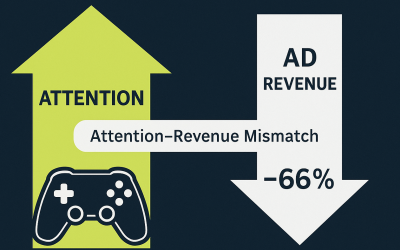App Engagement with or without Monetization: Finding the Balance
In the crowded app marketplace, app download rates are no longer growing at the pace they once did. In the United States alone, download rates have dropped by nearly 20% in recent years. While app downloads used to signal an app’s success, they never told the whole story. Many apps boast millions of downloads but struggle to maintain a significant number of active users. In reality, high download numbers without regular engagement or meaningful monetization won’t make an app successful.
As a result, the focus is shifting from raw download metrics to app usage and engagement metrics.
Contents
- 1 The Pitfalls of Using Engagement Alone as a Success Metric
- 2 Why Monetization Matters: Beyond Just Keeping Users Engaged
- 3 The Value of Rewarded Video Ads for App Monetization
- 4 Finding the Equilibrium: Balancing Engagement and Monetization
- 5 Creating a Value System That Makes Sense for Your App
- 6 Strategies for Successful App Monetization Without Alienating Users
- 7 Measuring Success: Key Performance Metrics for Monetization
- 8 Enhancing App Experience through Data-Driven Insights
- 9 Conclusion: Make Engagement and Monetization Work Together
The Pitfalls of Using Engagement Alone as a Success Metric
Measuring app engagement is essential, but it’s not enough to rely on engagement alone to gauge an app’s success. Imagine owning a bar with 100 patrons, yet none of them order drinks or food. It may look busy, but it’s not profitable. Similarly, an app with millions of active users but no revenue-generating strategy isn’t maximizing its potential. Mere engagement without monetization is a missed opportunity.
To build a successful app, it’s critical to combine engagement with effective monetization strategies. Engaged users provide a prime opportunity to generate revenue, but it must be done in a way that doesn’t disrupt their experience. Developers need to create value through monetization methods that fit the app’s nature and user expectations.
Why Monetization Matters: Beyond Just Keeping Users Engaged
Focusing on how much revenue you generate per active user (ARPU, or Average Revenue Per User) provides a fuller picture of success. Even with high engagement levels, if users don’t contribute to revenue, your app won’t achieve sustainable growth. The key is finding the right monetization methods that allow users to feel rewarded, not burdened, by engaging with revenue-generating elements. Rewarded video ads, for instance, offer users something valuable, like extra lives or in-game currency, in exchange for watching ads.
While balancing engagement and monetization can be tricky, well-integrated ad strategies can benefit both developers and users, enhancing both engagement and revenue.
The Value of Rewarded Video Ads for App Monetization
One of the most effective ways to monetize an engaged user base is through rewarded video ads. Rewarded video ads allow users to choose when to watch ads in exchange for benefits, making the experience feel less intrusive and more voluntary. By integrating rewarded ads at natural points in the user journey, like after a level-up or before accessing a premium feature, developers offer a value exchange that enhances user satisfaction.
Rewarded ads are a popular choice because they:
- Increase Engagement: Users interact with the app longer when they can gain in-game rewards by watching ads.
- Boost Retention: When users feel they’re receiving benefits, they’re more likely to return and keep using the app.
- Enhance Revenue Without Sacrificing Experience: Users are generally more tolerant of ads when they gain something in return, which improves the overall experience.
Finding the Equilibrium: Balancing Engagement and Monetization
An effective monetization strategy hinges on finding the sweet spot between what users are willing to pay (in time or money) and the value the app provides. Overcharging or overwhelming users with ads can drive them away. Conversely, underpricing can mean missing out on potential revenue.
This balance is often achieved by measuring and iterating on metrics like:
- ARPU: How much each active user brings in on average.
- eCPM (Effective Cost per Mille): The revenue generated per thousand ad impressions.
- Retention Rate: How many users continue using the app over time, especially after engaging with ads.
Setting up a fair and attractive value exchange helps prevent users from feeling that ads are a burden. For example, in a game app, rewarded video ads might offer players additional lives, coins, or power-ups, letting them feel in control of the ad experience. These rewards must be enticing enough to encourage engagement but not so generous that users can bypass in-app purchases altogether.
Creating a Value System That Makes Sense for Your App
Every app is different, and creating a “not so perfect but close enough” value system is more about aligning monetization with the app’s purpose. For gaming apps, this often involves a mix of in-app purchases and rewarded video ads. In productivity or content apps, users might pay for premium features or content access instead.
A well-constructed value system takes into account:
- User Preferences: Understanding what types of ads and rewards appeal most to users.
- Frequency: Deciding how often ads or prompts for in-app purchases appear to avoid overwhelming users.
- Reward Quality: Offering rewards that feel valuable without disrupting gameplay or overall app flow.
This value system should be fluid, changing based on user feedback and performance metrics. Regularly assessing user reactions to ads and tracking engagement and ARPU can help developers adjust the system to maximize both engagement and revenue.
Strategies for Successful App Monetization Without Alienating Users
While the goal is to make money, doing so without alienating users requires a balanced approach. Here are some monetization strategies that keep users engaged while generating revenue:
- Rewarded Video Ads: As discussed, these ads allow users to watch short videos for rewards. It’s a flexible and user-friendly model, widely used in gaming apps.
- In-App Purchases: Offering premium items, upgrades, or levels as in-app purchases lets users enhance their experience on their terms. This can be highly effective when paired with rewarded ads.
- Subscription Models: Especially popular in productivity, streaming, and content-focused apps, subscriptions generate steady revenue from engaged users willing to pay for a premium experience.
- Freemium with Ads: Offering a free app version with ads, alongside an ad-free paid version, gives users control over their experience.
- Interstitial and Banner Ads: Carefully timed display ads in non-intrusive locations can add to revenue without interrupting the user experience.
Each of these methods has strengths and weaknesses, and it’s often a combination of several that yields the best results.
Measuring Success: Key Performance Metrics for Monetization
Monitoring the right metrics ensures that your monetization strategy isn’t negatively impacting engagement. Key performance indicators to track include:
- ARPU: This shows the effectiveness of your monetization strategy per user.
- Retention Rate: A high retention rate indicates users are satisfied and likely returning.
- Engagement: Time spent in-app and frequency of visits helps measure engagement levels.
- eCPM: This is particularly useful in understanding the performance of ads and identifying areas for improvement.
- Ad Impressions and Click-Through Rate (CTR): Tracking these for each ad type can reveal which formats are most effective.
Enhancing App Experience through Data-Driven Insights
To optimize engagement and monetization, leverage data analytics to understand user behavior. Analyze metrics like time spent on certain features, common drop-off points, and the popularity of rewarded ads or in-app purchases. Data insights can guide your strategies, helping refine ad placements, reward offerings, and more.
For instance, if a high percentage of users are watching rewarded ads but skipping in-app purchases, you could adjust the value of the rewards or prompt users with time-sensitive offers. With data, you can adjust your monetization strategy based on user trends, ultimately boosting revenue while maintaining a positive experience.
Conclusion: Make Engagement and Monetization Work Together
Success in today’s app market requires a delicate balance of engagement and monetization. Apps that maintain active users without effective monetization are leaving potential revenue untapped. Rewarded ads, in-app purchases, and subscriptions offer ways to maximize both engagement and revenue. Remember that each app is unique, so find the best combination that aligns with your app’s purpose, audience, and monetization goals.
When executed thoughtfully, monetization strategies can enhance user satisfaction and generate sustainable revenue, proving that engagement and monetization are not just compatible but complementary.



